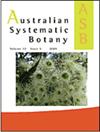形态学和分子证据驳斥了光脉藻(Fabacee:Mirbeleae)的广泛范围,对分类学、生物地理学和保护都有意义
IF 1.6
3区 生物学
Q4 EVOLUTIONARY BIOLOGY
引用次数: 2
摘要
摘要形态学和单核苷酸多态性数据支持毛蕨分裂。分为八个物种,其中一个在维多利亚州,另外七个在新南威尔士州东部和北部。新发现了6个物种,其中5个是大蓝山世界遗产区和毗邻大分水岭砂岩地貌的狭窄范围特有物种,比如光斑斑蝶(P. glabra)。从广泛的光斑拟南芥中发现的6个新物种对保护管理具有重要意义,包括对光斑拟南芥本身,它的分布比以前认为的要小,对栖息地的要求也比以前认为的要精确。其中一个新物种,P. percussa,只在1971年的一次采集中被发现。一些蓝山地区特有的Pultenaea物种的出现可能是由土壤多样性和地形复杂性的结合来解释的,这可能共同促进了小的异域种群之间的分化。光叶假单胞与柔叶假单胞杂交研究。首次记录;然而,观察到的两个物种之间渐渗的证据有限。描述了以下新分类群:虎皮Pultenaea aculeata M.A.M.Renner, P.H.Weston & s.k arke, percusa Pultenaea M.A.M.Renner & P.H.Weston, furcata M.A.M.Renner & r.l.b reter,变型Pultenaea M.A.M.Renner & P.H.Weston,变型Pultenaea var. angusta M.A.M.Renner, P.H.Weston, p.a.h.w eston,变型Pultenaea praecipua M.A.M.Renner & P.H.Weston, praecipua亚种。temperata M.A.M.Renner & R.L.Barrett, Pultenaea tenebrosa M.A.M.Renner, P.H.Weston & s.k larke。选集型指定为绒毛Pultenaea var. glabrescens . Benth。和Pultenaea weindorferi Reader。本文章由计算机程序翻译,如有差异,请以英文原文为准。
Morphological and molecular evidence refute a broad circumscription for Pultenaea glabra (Fabaceae: Mirbelieae), with implications for taxonomy, biogeography, and conservation
Abstract. Morphological and single-nucleotide polymorphism data support splitting Pultenaea glabra Benth. into eight species, including one in Victoria, and seven in eastern and northern New South Wales. Six species are newly described, five of which are, like P. glabra, narrow-range endemics within the Greater Blue Mountains World Heritage Area and adjacent sandstone landforms of the Great Dividing Range. The recognition of six new species from what was broadly P. glabra has implications for conservation management, including for P. glabra itself, which has a smaller distribution and more precise habitat requirements than previously thought. One of the new species, P. percussa, is known by a single 1971 gathering only. The occurrence of several narrow-range Blue Mountains endemic Pultenaea species may be explained by the combination of edaphic diversity and topographic complexity, which could act in concert to promote divergences among small, allopatric populations. Hybrids between P. glabra and P. flexilis Sm. are documented for the first time; however, limited evidence for introgression between the two species was observed. The following new taxa are described: Pultenaea aculeata M.A.M.Renner, P.H.Weston & S.Clarke, Pultenaea percussa M.A.M.Renner & P.H.Weston, Pultenaea furcata M.A.M.Renner & R.L.Barrett, Pultenaea mutabilis M.A.M.Renner & P.H.Weston, Pultenaea mutabilis var. angusta M.A.M.Renner, P.H.Weston, & S.Clarke, Pultenaea praecipua M.A.M.Renner & P.H.Weston, Pultenaea praecipua subsp. temperata M.A.M.Renner & R.L.Barrett, and Pultenaea tenebrosa M.A.M.Renner, P.H.Weston & S.Clarke. Lectotypes are designated for Pultenaea villosa var. glabrescens Benth. and Pultenaea weindorferi Reader.
求助全文
通过发布文献求助,成功后即可免费获取论文全文。
去求助
来源期刊

Australian Systematic Botany
生物-进化生物学
CiteScore
3.10
自引率
12.50%
发文量
12
审稿时长
>12 weeks
期刊介绍:
Australian Systematic Botany is an international journal devoted to the systematics, taxonomy, and related aspects of biogeography and evolution of all algae, fungi and plants, including fossils. Descriptive taxonomic papers should normally constitute a comprehensive treatment of a group. Short papers on individual species and nomenclatural papers must contain significant new information of broader interest to be considered. The prestigious L.A.S. Johnson Review Series is published. Other review articles will also be considered. All papers are peer reviewed.
Australian Systematic Botany is published with the endorsement of the Commonwealth Scientific and Industrial Research Organisation (CSIRO) and the Australian Academy of Science.
 求助内容:
求助内容: 应助结果提醒方式:
应助结果提醒方式:


